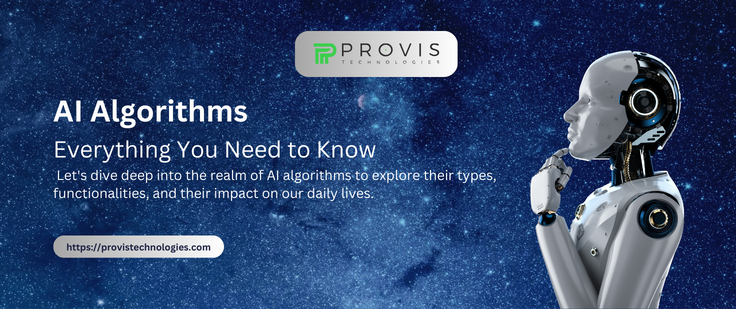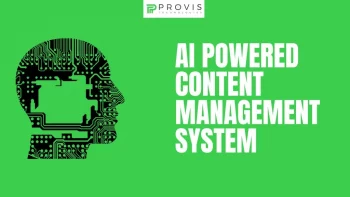Today, AI (Artificial Intelligence) has evolved into a transformative force. In its core lies a sophisticated set of algorithms that makes it so capable & powerful. These algorithms allow these machines to learn, reason, and make decisions. Let’s dive deep into the realm of AI algorithms to explore their types, functionalities, and their impact on our daily lives.
Understanding AI Algorithms
At the heart of AI lies the concept of algorithms, which are step-by-step procedures or formulas for solving problems. In the context of AI, algorithms are designed to enable machines to emulate human-like intelligence. These algorithms are the building blocks of machine learning, a subset of AI that focuses on making systems learn from data.
Types of AI Algorithms
Supervised Learning Algorithms
- In supervised learning, algorithms are trained on a labeled dataset, where each input has a corresponding output.
- Linear regression is a common algorithm that supports vector machines and neural networks.
- These algorithms excel in tasks such as classification and regression.
Unsupervised Learning Algorithms
- Unsupervised learning involves training algorithms on unlabeled data, allowing them to identify patterns and relationships independently.
- Clustering algorithms, like K-means and hierarchical clustering, are popular in unsupervised learning.
- This type is ideal for tasks like clustering, dimensionality reduction, and association.
Reinforcement Learning Algorithms
- Reinforcement learning involves an agent that learns to make decisions by receiving feedback in the form of rewards or punishments.
- Q-learning and deep reinforcement learning, popularized by applications like AlphaGo, are examples.
- This type is crucial in scenarios where an agent must learn optimal strategies through trial and error.
Natural Language Processing (NLP) Algorithms
- To understand, interpret, and generate human language – the NLP mechanism is used.
- Named Entity Recognition (NER), sentiment analysis, and language translation are tasks performed by NLP algorithms.
- Transformers, recurrent neural networks (RNNs), and word embeddings are integral components of NLP.
Evolutionary Algorithms
- Inspired by the process of natural selection, evolutionary algorithms mimic the evolution of species to find optimal solutions.
- Genetic algorithms and genetic programming are examples used in optimization and search problems.
Neural Networks
- Neural networks, inspired by the human brain, consist of interconnected nodes (neurons) arranged in layers.
- Deep learning, a subset of machine learning, heavily relies on neural networks for tasks such as image and speech recognition.
- Convolutional Neural Networks (CNNs) and Recurrent Neural Networks (RNNs) are popular architectures.
Don’t Miss:- How Will AI Affect the Design of UI/UX?
Functionalities of AI Algorithms
Pattern Recognition
- AI algorithms excel at recognizing patterns in vast datasets, allowing them to identify trends and make predictions.
- This capability is leveraged in applications like fraud detection, image recognition, and predictive analytics.
Decision Making
- Through learning from data, AI algorithms can make informed decisions in complex and dynamic environments.
- Autonomous vehicles, for instance, use reinforcement learning algorithms to navigate and make split-second decisions.
Personalization
- AI algorithms power recommendation systems that personalize content based on user behavior.
- Streaming services, e-commerce platforms, and social media utilize these algorithms to enhance user experience.
Automation
- Automation is a primary outcome of AI algorithms, streamlining repetitive tasks and increasing efficiency.
- Robotic process automation (RPA) relies on algorithms to mimic human interactions with digital systems.
Natural Language Understanding
- NLP algorithms enable machines to understand and generate human language, facilitating communication between humans and machines.
- Virtual assistants, chatbots, and language translation services rely on NLP for effective communication.
Must Know:- How to Improve Your Website With Artificial Intelligence?
Impact on Daily Life
Healthcare
- AI algorithms are transforming healthcare with applications in medical imaging analysis, drug discovery, and personalized medicine.
- Diagnostic tools powered by AI enhance accuracy and speed in disease detection.
Finance
- In the financial sector, algorithms are used for fraud detection, risk management, and algorithmic trading.
- These algorithms analyze vast amounts of financial data to make data-driven decisions.
Education
- AI algorithms contribute to personalized learning experiences by adapting content to individual student needs.
- Intelligent tutoring systems use algorithms to assess student performance and provide targeted support.
Smart Cities
- AI algorithms play a significant role in building smart cities by optimizing traffic flow, managing energy consumption, and enhancing public safety.
- Smart surveillance systems use computer vision algorithms for real-time monitoring.
Entertainment
- Streaming platforms leverage recommendation algorithms to suggest content based on user preferences.
- AI algorithms are also used in content creation, generating Music, art, and even writing.
Related Blog:- How to Create an App Using AI/ML for Your Business
Challenges & Future Directions
Ethical Considerations
- AI algorithms raise ethical concerns, such as bias in decision-making and the potential for job displacement.
- Ensuring fairness and transparency in algorithmic processes is a crucial challenge.
Interpretable AI
- Understanding the decisions made by algorithms remains a challenge, particularly in complex deep-learning models.
- Developing interpretable AI is essential for building trust and accountability.
Continual Learning
- AI algorithms often struggle with adapting to new information over time.
- Research in continual learning aims to make AI systems more adaptable and capable of learning from evolving data.
Collaboration with Humans
- The future of AI lies in collaborative efforts between machines and humans.
- Human-in-the-loop AI systems, where humans and AI work together, are gaining importance.
Conclusion
AI algorithms are the backbone of artificial intelligence, driving its capabilities across various domains. As these algorithms continue to evolve, their impact on daily life will only intensify, ushering in a new era of innovation and transformation. It is imperative to navigate the challenges posed by AI responsibly, ensuring that the benefits are harnessed for the greater good of society. As we journey further into the realm of AI, understanding and embracing the intricacies of its algorithms will be key to unlocking its full potential.
Written By
Author's Picks
- How to Build a Custom and Scalable AI SaaS Product | A Step-by-Step Process and Cost Estimation for Businesses
- 04/10/2024
- Maximizing Potential: AI Integration Services in the Future SEO
- 21/11/2023
- How AI Is Shaping The Future Of Wealth Management – Benefits And Applications
- 19/09/2024





